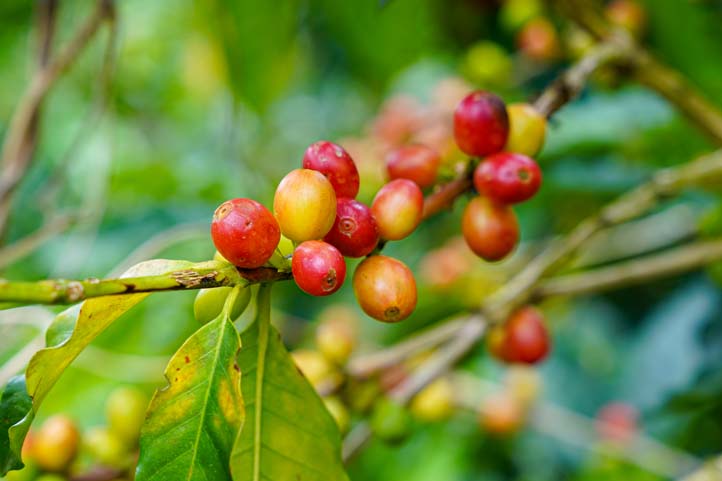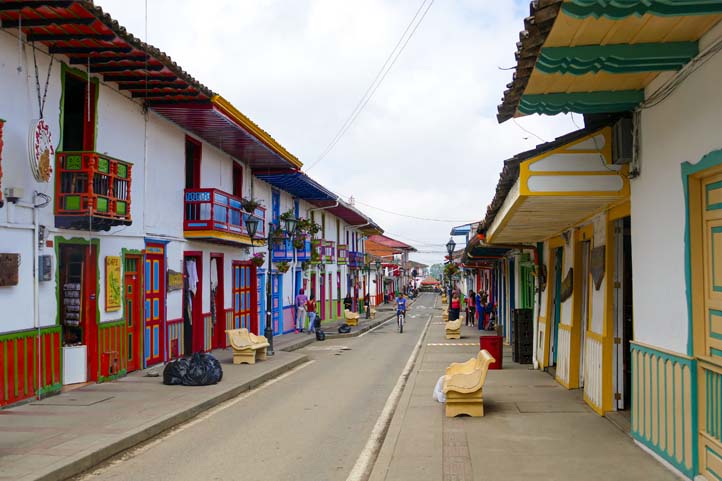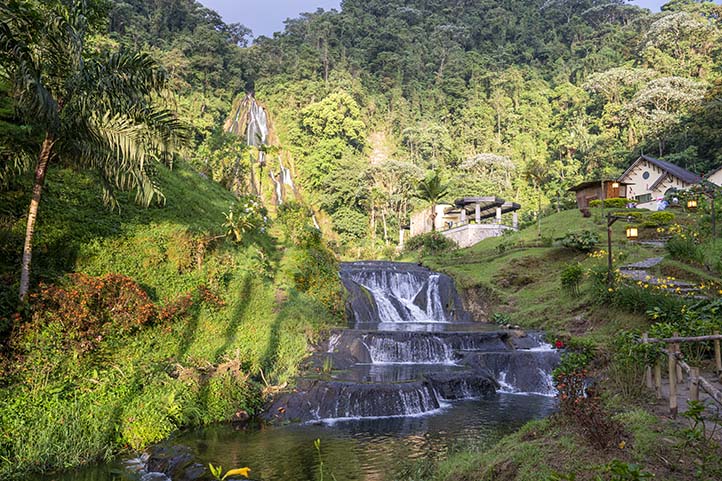Updated on 03/13/2024
Dear Valued Readers,
Greetings from our team at Pelecanus in Bogota, where we specialize in crafting exceptional Colombian holiday experiences. We take great joy in extending our services to organize a seamless and unforgettable trip tailored to your preferences.
At the end of this guide, you will find a list of many other helpful Colombia travel guides.
Content
Overview of the Coffee Triangle
The Coffee Triangle, or Eje Cafetero, comprises three departments: Caldas, Quindio, and Risaralda. Nestled within the Colombian Andes, this region forms a part of the larger Paisaje Cultural Cafetero (Coffee Cultural Landscape), known for its picturesque scenery and coffee plantations. The Coffee Triangle is situated centrally within Colombia, making it accessible from major cities.
Historical Timeline
- Pre-Columbian Era: The regions that now comprise the Coffee Triangle were inhabited by indigenous groups such as the Quimbaya and the Pijaos, known for their intricate gold work and agriculture.
- Early 16th Century: The Spanish conquest led to the colonization of the area, with the indigenous population declining due to diseases and conflict.
- 18th Century: Spanish settlers established small farms and began cultivating crops. Coffee was introduced to Colombia during this time, although it wasn’t the primary crop.
- Early 19th Century: Post-independence, Colombian farmers began cultivating coffee in larger quantities as the internal conflict decreased and new lands became available for agriculture.
- Late 19th to Early 20th Century: With the construction of the Panama Canal and the development of the railway in Colombia, coffee from the region found international markets, leading to a boom in coffee growing.
- 1927: The National Federation of Coffee Growers of Colombia (Federación Nacional de Cafeteros de Colombia) was established to support the industry, promote Colombian coffee, and stabilize prices.
- 1940s-1960s: The Coffee Triangle became more popularized as the National Federation of Coffee Growers marketed Colombian coffee globally, notably with the creation of the Juan Valdez symbol in 1959.
- 1970s-1980s: Political stability and global recognition of Colombian coffee’s quality increased the Coffee Triangle’s popularity, with a focus on sustainable practices and the preservation of traditional methods.
- 2011: UNESCO declared the Coffee Cultural Landscape of Colombia, which includes the Coffee Triangle, a World Heritage Site, recognizing the centuries-old tradition of coffee growing in this region and the unique way it has shaped the landscape and culture.
Climate, Ecosystem, and Geography of the Coffee Triangle
The Coffee Triangle’s climate, ecosystem, and geography are intrinsically connected, each element influencing the other to create a region of extraordinary natural diversity and agricultural productivity.
Geographical Landscape
- The region spans the central Andes of Colombia, characterized by undulating mountains, fertile valleys, and volcanic soils.
- Nevado del Huila: Rising to 5,364 meters (17,598 feet), Nevado del Huila is the highest peak in the Coffee Triangle. It’s an active stratovolcano that has shown recent activity, reminding us of the powerful forces that have shaped this landscape over millennia.
- Nevado del Ruiz: At 5,321 meters (17,457 feet), Nevado del Ruiz is the most well-known volcano in the region due to its tragic history. The 1985 eruption caused a devastating lahar that engulfed the town of Armero, underscoring the need for continuous monitoring of volcanic activity.
- Nevado del Tolima: This stratovolcano stands at 5,215 meters (17,110 feet) and is characterized by its conical shape. It’s currently dormant, with its last known eruption occurring in the early 1940s.
- Santa Isabel: The glacier-clad peak of Santa Isabel reaches 4,950 meters (16,240 feet) and is considered dormant. Its retreating glaciers are often studied for insights into climate change.
- Paramillo del Quindío: At 4,750 meters (15,584 feet), Paramillo del Quindío is another dormant stratovolcano. It’s part of the Los Nevados National Natural Park and is a popular destination for hikers and nature enthusiasts.

Volcanic Activity
The volcanic nature of these peaks plays a crucial role in the region. Volcanic soils are famously fertile and rich in minerals and nutrients, which contributes to the high-quality coffee production for which the Coffee Triangle is renowned. However, the threat of volcanic activity is ever-present.
The Colombian Geological Service closely monitors these volcanoes, particularly Nevado del Huila and Nevado del Ruiz, for any signs of unrest. The volcanic activity has also led to the creation of thermal springs, which are indeed a tourist attraction.
Additionally, the volcanoes have shaped the ecosystem, with the altitudinal gradients providing diverse habitats for a wide range of species. The peaks are not only markers of the region’s volcanic activity but also guardians of its rich biodiversity.
Climate Variation
- The climate ranges from tropical rainforest (Af) in the lower elevations to tropical monsoon (Am) in some parts, with a pronounced variation due to the altitude.
- Temperature averages vary from a cooler 12 °C (53.6 °F) in the high-altitude Nevados to a warmer 24 °C (75.2 °F) in the coffee-growing valleys.
- The region receives substantial rainfall, typically between 1,700 mm (66.9 inches) and 2,300 mm (90.5 inches) annually, with higher elevations receiving more precipitation.
Ecosystem Diversity
- Altitudes range from coffee-growing zones at 1,200 to 1,800 meters (3,937 to 5,906 feet) to the alpine conditions of the Nevados.
- This range supports a rich biodiversity, from the coffee plantations’ birdlife and insects to the high-mountain flora and fauna, including endemic species like the frailejón plants.
- The Nevados area, part of the Los Nevados National Natural Park, is a critical water source and habitat for endangered species like the Andean Condor.
Climate and Coffee Cultivation
- The varied microclimates within the Coffee Triangle contribute to the unique quality and flavors of Colombian coffee.
- These microclimates are essential for coffee plants, which thrive in stable temperatures and specific rainfall patterns.
Environmental Impacts and Conservation
- The region is subject to climate change, with shifts in temperature and rainfall patterns observed, potentially impacting coffee production and local ecosystems.
- Conservation efforts are in place, including national parks and reserves, to protect the biodiversity and traditional coffee cultivation practices that define the region.
Coffee Production in the Coffee Triangle
Coffee production in Colombia’s Coffee Triangle is both a cultural hallmark and an economic mainstay. Here’s how it stands out:
Production Scale and Quality
- National Comparison: Colombia is the third-largest coffee producer in the world. Within Colombia, the Coffee Triangle contributes significantly to the national output. While departments like Huila and Antioquia have surpassed traditional Triangle departments in volume, the Triangle remains the symbolic heart of Colombian coffee.
- Quality Over Quantity: Despite not being the largest producer by volume, the Coffee Triangle is renowned for the quality of its coffee. The combination of high altitude, tropical climate, and rich volcanic soil in this region creates ideal conditions for growing Arabica coffee, which is highly sought after for its mild, well-balanced flavor.
Examples of Quality and Recognition
- Cup of Excellence: Coffees from the Triangle regularly feature in the prestigious Cup of Excellence, where the best Colombian coffees are judged and auctioned, often achieving top prices for their exceptional quality.
- Denomination of Origin: Coffees from the region have been awarded the Denomination of Origin status, which recognizes their unique characteristics that are closely linked to their geographical origin, similar to the recognition given to Champagne or Parma Ham.
- Specialty Coffees: The region is known for producing specialty coffees that have distinct taste profiles such as bright acidity, medium to full body, and flavors ranging from chocolate and nuts to fruity and floral notes, depending on the microclimate where they are grown.
Demographics of the Coffee Triangle
The demographics of the Coffee Triangle are reflective of its historical development as a hub for coffee cultivation and its status as a cultural landmark:
Population Statistics
- Manizales: The capital of Caldas, Manizales has a population of approximately 400,000 people. It’s known for its educational institutions and cultural festivals.
- Armenia: With around 300,000 residents, Armenia is the capital of Quindío and acts as a central point for visitors exploring the coffee region.
- Pereira: As the largest city in the Coffee Triangle and the capital of Risaralda, Pereira houses over 460,000 inhabitants and serves as an economic and commercial center for the region.
Urbanization and Growth
- The urban centers of the Coffee Triangle have experienced growth due to rural-to-urban migration, with many seeking opportunities in the service and tourism sectors.
- Despite this, a significant portion of the population remains in rural areas, engaged in coffee farming and other agricultural activities.
Social Dynamics
- The people of the Coffee Triangle are known for their warmth and hospitality, often welcoming tourists into their homes and sharing the local way of life.
- The population is characterized by a strong sense of community, with many social events centered around coffee cultivation and local traditions.
Tourism in the Coffee Triangle
- 2010s: Tourism becomes an increasingly important economic activity in the region.
- 2019: The Coffee Triangle records over 1 million visits, with tourism being recognized as a key component of the region’s economy.
- Present: The region offers a variety of coffee-related tours, cultural festivals, and nature excursions, attracting visitors worldwide.
Tourist Destinations and Activities in the Coffee Triangle from North to South
Travel through the Coffee Triangle, starting in the north with Caldas and moving southward, discovering the blend of culture, architecture, and natural beauty each location offers.
Northern Gateway of the Coffee Triangle: The Department of Caldas
Salamina
- Historic Architecture: Stroll through the streets of Salamina and admire the intricate details of colonial-era buildings.
- Bosque de Samaria: Take guided walks to see towering wax palms and the diverse ecosystem they support.
- Coffee Farm Visits: Experience the journey of coffee from bean to cup, and learn about cultivation on local farms.
Manizales – The Capital of Caldas
- Cathedral of Manizales: Climb the cathedral’s tower for a 360-degree view of the city and the surrounding mountains.
- Recinto del Pensamiento: Connect with nature while exploring the butterfly vivarium and hummingbird observatory.
- Los Yarumos Ecopark: Engage in adventure activities like zip-lining or learn about local conservation efforts.
- Fundadores Theater: Catch a live performance or cultural event at this central artistic venue.
Manizales Outskirts
- Nevado del Ruiz: Enjoy the hot springs and scenic trails around this active volcano.
- Hotel Termales del Ruiz: Stay at this hotel for direct access to the healing thermal waters and nearby nature trails.
- Club Campestre Manizales: A golf course offering not just golfing but also beautiful landscapes for a relaxing day out.
- Tinamú Birding Nature Reserve: Dedicated trails for birdwatching enthusiasts to spot and photograph a variety of bird species.
Other Destinations in Caldas
- Riosucio: Famous for its Carnival, celebrated every two years with vibrant parades and cultural expressions.
- Aguadas: Known for artisanal hat making; visit local workshops to see the craft in action.
Notable Spots in Caldas
- Nido del Condor: A spot where visitors might see the Andean condor. The area is suitable for hiking and nature photography.
- Hacienda Venecia: A coffee estate that offers a comprehensive coffee experience, including tastings and overnight stays.
- Termales La Quinta: A set of hot springs known for their picturesque setting and therapeutic properties, ideal for day visits or longer stays.
The Heart of Coffee Triangle: The Department of Risaralda
Pereira – The Capital of Risaralda
- Bolívar Square: The central square of Pereira, this space is framed by historical architecture and hosts many of the city’s key events.
- Matecaña City Zoo: Home to a diverse collection of animals, the zoo focuses on conservation and education about Colombia’s wildlife.
- Otún Quimbaya Flora and Fauna Sanctuary: A protected area that provides an excellent spot for birdwatching and encountering the region’s biodiversity.
Santa Rosa de Cabal
- Thermal Springs: The hot springs are a major attraction, offering relaxation and wellness benefits in a natural setting.
- Santa Rosa Waterfalls: These cascading waterfalls are accessible through scenic trails that showcase the natural beauty of the area.
Marsella
- Coffee Cultural House: An educational center set in a traditional house where visitors can learn about the historical aspects of coffee production.
- Jesús María Morales Park: The town’s main park, a hub for Marsella’s community activities and cultural events.
Apía
- Adventure Activities: Apía provides opportunities for eco-tourism, including paragliding and hiking, appealing to those looking for an adventure off the beaten track.
- Bird Watching: The region’s diverse altitudes offer rich bird habitats, ideal for birding enthusiasts.
Pueblo Rico
- Cultural Engagement: Visitors to Pueblo Rico can interact with the local indigenous and Afro-Colombian communities, gaining insights into their traditions and lifestyles.
Belén de Umbría
- Coffee Tours: Belén de Umbría offers immersive experiences on coffee farms, where visitors can learn about the coffee process and enjoy tastings.
The Heart and South of the Coffee Triangle: The Department of Quindio
Armenia: The Capital of Quindío
- National Coffee Park: This park provides a unique blend of amusement rides and coffee education.
- Quindío Botanical Garden: A tranquil spot for visitors to explore the region’s natural flora, including a butterfly house for close encounters with various butterfly species.
Salento
- Cocora Valley: Known for its breathtaking landscapes and the towering wax palm trees.
- Nevado del Tolima Hike: Adventurous visitors can take on the trek to the summit for spectacular views and a sense of accomplishment.
- Salento’s Town Square: A vibrant hub where travelers can enjoy local cuisine and shop for artisanal crafts.
- Coffee Tours: Engage with local coffee growers and learn the nuances of coffee production in the region.

Filandia
- Viewpoint Tower: A landmark offering 360-degree views of the Coffee Triangle’s rolling hills and lush plantations.
- Barbas Bremen Nature Reserve: Ideal for ecotourism, this reserve allows visitors to experience the region’s biodiversity in a cloud forest setting.
- Colorful Streets: Wander the colorful streets of Filandia, which showcase the town’s unique architecture and artisan shops.
- Cultural Workshops: Participate in local workshops that celebrate the town’s arts and crafts, providing a hands-on experience with traditional techniques.
Buenavista
- Coffee Alberto: A renowned coffee farm that highlights sustainable practices and offers insights into the coffee-making process.
- Town Square: Reflects the slow-paced, coffee-centric lifestyle characteristic of the region.
Pijao
- Cittaslow Movement: Experience the relaxed lifestyle of one of Colombia’s first ‘slow cities,’ emphasizing quality of life and environmental sustainability.
Quindío’s Gold and Culture
- Gold Museum in Armenia: Explore the historical significance of gold in the region and its impact on local culture.
- Park Los Arrieros: A cultural theme park that pays homage to the region’s history and the lives of the Arrieros.
Trekking and Natural Wonders
- Volcano El Machín: The surrounding areas offer nature trails and the opportunity for geological exploration.
Accommodation Guide for the Coffee Triangle
Types of Accommodation in the Coffee Triangle
Traditional Haciendas
- Region: Widespread across Salento, Armenia, and Pereira.
- Description: Historic coffee farms converted into guesthouses, offering an authentic stay and insight into coffee culture.
- Activities: Coffee farm tours, horseback riding, and traditional cuisine tasting.

Eco-Lodges
- Region: Common in the areas near the natural parks and reserves, such as Los Nevados National Park and Barbas Bremen Nature Reserve.
- Description: Environmentally friendly accommodations often located in more secluded areas, perfect for nature lovers.
- Activities: Bird watching, hiking, and eco-tours.
Boutique Hotels
- Region: Mostly found in the hearts of towns like Salento, Filandia, and Armenia.
- Description: Small, often upscale hotels with unique décor that reflects the local culture and history.
- Activities: Cultural workshops, city tours, and local gastronomy.
Hostels
- Region: Popular in more tourist-centric areas such as Salento and the outskirts of Manizales.
- Description: Budget-friendly options catering to solo travelers, backpackers, and groups looking for a social atmosphere.
- Activities: Shared tours, language exchange nights, and communal dining experiences.
Guesthouses and B&Bs
- Region: Available throughout the Coffee Triangle, with a concentration in residential areas of Armenia and Pereira.
- Description: Cozy, family-run accommodations that offer a more intimate experience of local hospitality.
- Activities: Personalized tours, home-cooked meals, and interaction with local hosts.
Finca Hotels
- Region: Scattered among the rural landscapes, particularly around Buenavista and Pijao.
- Description: Country house hotels that offer a rural retreat with modern amenities, often set on active coffee farms.
- Activities: Swimming, nature walks, and relaxation in serene settings.
Glamping Sites
- Region: Emerging around the valleys and highlands, especially in the vicinity of Cocora Valley.
- Description: Luxury camping with comfortable bedding in tents or domes, combining the rustic outdoor experience with comfort.
- Activities: Stargazing, on-site nature trails, and campfires.
Mountain Cabins
- Region: Located in higher altitude areas, especially around Nevado del Ruiz and Nevado del Tolima.
- Description: Rustic cabins providing a mountain getaway, suitable for those looking to unplug and enjoy the tranquility of the Andean forests.
- Activities: Mountain trekking, hot springs, and wildlife observation.
If you want to know more about lodging options in the coffee region, we recommend you to visit these blogs:
- The Best Hotels in the Coffee Triangle Colombia
- Top 7 Lodgings Near Cocora Valley, Salento
- The 9 Best Budget-Friendly Hotels in Colombia’s Coffee Region
- The 12 Best Hotels in Salento Colombia
- The 14 Best Hostels in Salento Colombia
Cultural Agenda of the Coffee Triangle
January
Feria de Manizales: A week-long festival in Manizales featuring bullfights, music, dancing, and beauty pageants.
June
Fiesta Nacional de Café: A national coffee festival celebrating the coffee culture with parades, beauty contests, and exhibitions in the town of Calarca.
August
Fiestas de las Cosechas: Harvest festivals celebrating the region’s agricultural bounty with various cultural and social events.
September
Festivo de Sabores, Sonidos y Saberes: A festival that showcases the region’s gastronomy, music, and knowledge, often featuring local artists and cuisine.
December
Concurso Nacional de Velas y Faroles: A national contest in Quimbaya where participants create and display intricate candles and lanterns, illuminating the town with festive lights.
Food Guide for the Coffee Triangle
- Bandera Paisa (Paisa Platter): This hearty meal is a staple in the region, featuring beans, rice, ground meat, plantain, arepa (corn cake), avocado, chorizo, and a fried egg. It’s a reflection of the region’s agrarian roots.
- Trout: With numerous rivers and streams, the Coffee Triangle offers fresh trout prepared in various styles, often served with garlic, butter, and accompanied by a side of patacones (fried plantains) and salad.
- Arepa de Choclo: Sweet corn cakes that are often enjoyed for breakfast or as a snack, topped with butter or cheese.
- Coffee: No guide would be complete without coffee. Beyond just drinking, local cuisine incorporates coffee into various dishes, including sauces and desserts.
- Sancocho: A traditional Colombian soup made with chicken, plantains, corn, and other vegetables, often served as a comforting meal.
- Fruits: The region’s tropical climate yields a variety of exotic fruits. Make sure to try fresh fruit juices or fruit salads with selections like lulo, guanábana, maracuyá, and papaya.
- Panela: Unrefined sugar cane, used in beverages like agua de panela, or in desserts. It’s also a common ingredient in savory dishes to add a touch of sweetness.
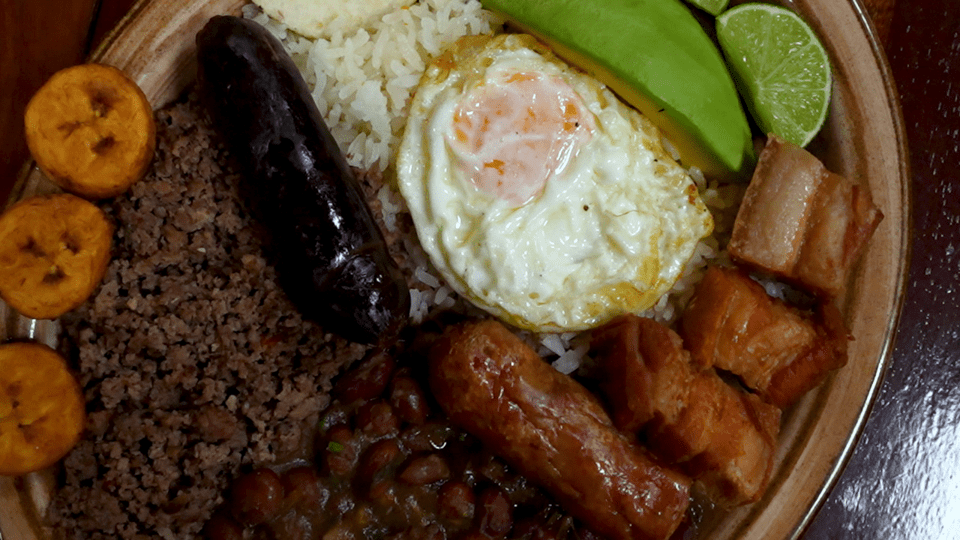
Best Time to Travel to the Coffee Zone
The best travel time for the Coffee Zone in Colombia is typically the dry seasons, which run from December to March and from July to August. During these periods, the weather is more predictable, and you’ll experience less rainfall, making it ideal for coffee farm tours and outdoor activities such as hiking in the Andean landscapes.
However, if you’re interested in experiencing local culture and festivals, it may be worth visiting during festival periods, even if they fall during the wetter months. Keep in mind that Colombia’s weather can be unpredictable, and it’s wise to be prepared for rain at any time of the year, especially in a region as lush and biodiverse as the Coffee Zone.
Transport Guide for the Coffee Triangle
The Coffee Triangle is well-connected by various modes of transport, making it accessible for travelers.
Airports
- Matecaña International Airport (PEI) in Pereira.
- El Edén International Airport (AXM) near Armenia.
- La Nubia Airport (MZL) in Manizales, with limited services.
Bus Terminals
- Terminal de Transportes Pereira: Connects to most cities and towns within the triangle and other parts of Colombia.
- Terminal de Transporte de Armenia: Offers extensive routes to various destinations.
- Terminal de Transporte de Manizales: Links Manizales with other significant locations.
Other Transport Options
- Rental Cars: Available for more personalized travel plans.
- Taxis and Rideshare: Taxis are widely used, and rideshare options are available in larger cities.
- Local Buses: An economical way to travel between cities and nearby towns.
- Bicycles: A popular option for exploring the rural landscapes, especially in Salento.
Specialized Local Transport
- Willy Jeeps: A traditional and iconic mode of transport in the Coffee Triangle, especially in Salento, where they are used for both transport and tours.
- Colectivos: Shared taxis or minibusses that provide an affordable and common means of transportation between towns.
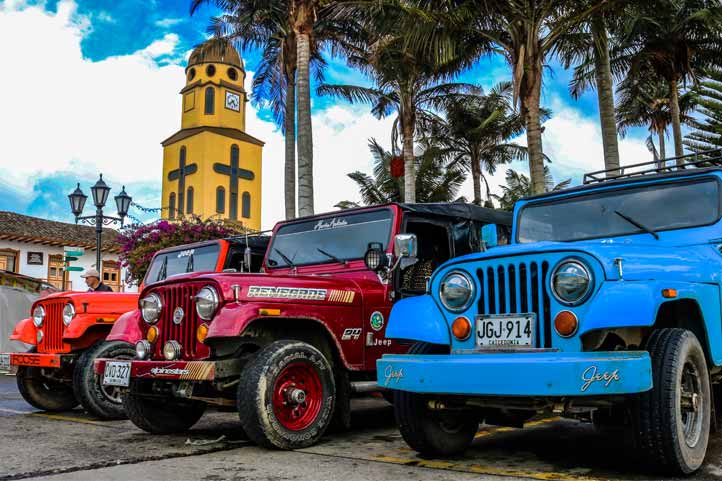
When traveling in the Coffee Triangle, it’s advised to be aware of the mountainous terrain, which can impact travel times. Plan and book your transport in advance during peak travel seasons and festivals to ensure availability.
My Likes and Dislikes of the Coffee Triangle: A Personal Perspective
What I Like About the Coffee Triangle
- Scenic Landscapes: The region boasts stunning views of coffee plantations and lush mountainous vegetation.
- Local Hospitality: The inhabitants are exceptionally friendly, offering a warm welcome to visitors.
- Charming Dialect: The local Spanish dialect is melodic and adds a unique charm to interactions.
What I Dislike About the Coffee Triangle
- Crowds During Peak Times: The area can become overly crowded during public holidays and peak tourist season.
- Travel Difficulties:
- Road closures are frequent, which can be due to various reasons like traffic accidents, ongoing construction, or landslides.
- Driving challenges, especially when entering or leaving the Coffee Triangle.
Colombia Travel Guides
Here you will find travel guides for the most popular regions in Colombia, which we have put together during our extensive travels around the country.
- Colombia Travel Guide
- Bogota Colombia Travel Guide
- Medellin Colombia Travel Guide
- Cartagena Colombia Travel Guide
- Santa Marta Colombia Travel Guide
- Cali Colombia Travel Guide
- Coffee Triangle Colombia Travel Guide
- Barranquilla Colombia Travel Guide
- La Guajira Colombia Travel Guide
- Tayrona Park Colombia Travel Guide
- Palomino Colombia Travel Guide
- San Andres Island Colombia Travel Guide
- Providencia Island Colombia Travel Guide
- Casanare Llanos Colombia Travel Guide
- Amazonas Colombia Travel Guide
- Chocó Colombia Travel Guide
- Santander Colombia Travel Guide
- Boyaca Colombia Travel Guide
Travel Guides to Colombia’s Small Towns
Here you will find travel guides for less popular destinations in Colombia. Some of these destinations are even real insider tips and not even known to the Colombians as travel destinations.
- Aguachica Colombia Travel Guide
- Arauca Colombia Travel Guide
- Armenia Colombia Travel Guide
- Barrancabermeja Colombia Travel Guide
- Bucaramanga Colombia Travel Guide
- Buenaventura Colombia Travel Guide
- Canyon Chicamocha Colombia Travel Guide
- El Carmen de Bolivar Colombia Travel Guide
- Caucasia Colombia Travel Guide
- Cucuta Colombia Travel Guide
- Florencia Colombia Travel Guide
- Ibagué Colombia Travel Guide
- Inirida Colombia Travel Guide
- Ipiales Colombia Travel Guide
- Magangue Colombia Travel Guide
- Manizales Colombia Travel Guide
- Mitu Colombia Travel Guide
- Mocoa Colombia Travel Guide
- Monteria Colombia Travel Guide
- Neiva Colombia Travel Guide
- Palmira Colombia Travel Guide
- Pasto Colombia Travel Guide
- Pereira Colombia Travel Guide
- Popayan Colombia Travel Guide
- Puerto Asis Colombia Travel Guide
- Puerto Carreno Colombia Travel Guide
- Quibdo Colombia Travel Guide
- Riohacha Colombia Travel Guide
- San José del Guaviare Colombia Travel Guide
- Sincelejo Colombia Travel Guide
- Sogamoso Colombia Travel Guide
- Tulua Colombia Travel Guide
- Tumaco Colombia Travel Guide
- Tunja Colombia Travel Guide
- Turbo Colombia Travel Guide
- Valledupar Colombia Travel Guide
- Villa de Leyva Colombia Travel Guide
- Villavicencio Colombia Travel Guide
- Yopal Colombia Travel Guide

